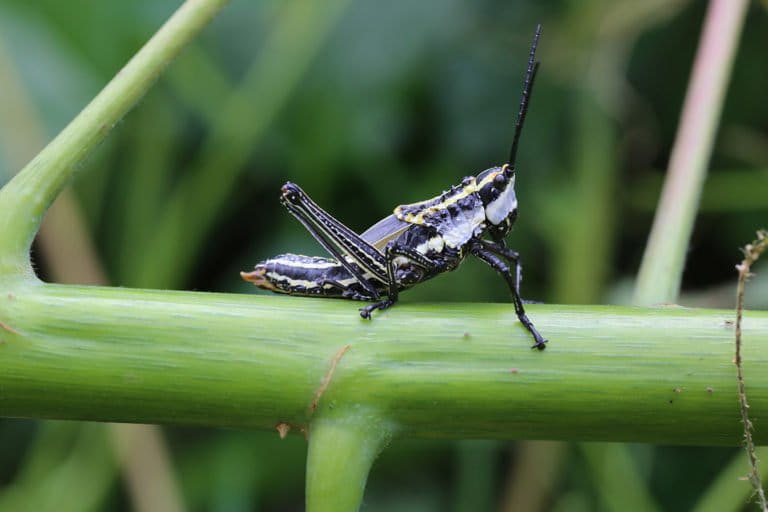- In May, Sri Lanka recorded a sporadic increase in crop-damaging yellow-spotted grasshoppers (Aularches miliaris), leading to concerns that a pest outbreak could impact food security.
- Sri Lankan experts are also watching as harmful desert locusts (Schistocerca gregaria) damage crops in neighboring India and Pakistan, though it seems unlikely these locusts will arrive in the island nation.
- The decline of natural predators and recent changes in the climate may be helping to increase the frequency of these potentially devastating insect invasions.
- Experts have used drones to map and verify crop damage caused by grasshoppers.
KURUNEGALA, Sri Lanka — With the COVID-19 pandemic contained following a strict two-month lockdown, Sri Lanka relaxed restrictions in late May 2020. But now, several farming communities are facing a second crisis in the form of hungry insects.
As the lockdown lifted, farmers and home gardeners from Mawathagama, a hamlet in Sri Lanka’s North Western province, wanted to resume cultivation, only to find a species of grasshopper destroying their crops.
Yellow-spotted grasshoppers (Aularches miliaris), also known as coffee locusts, first emerged in smaller numbers from a coconut plantation in the province, which is known for its coconut production. Within a few days, the insect numbers increased. The grasshoppers soon began emerging from nearby home gardens as well, and panic-stricken villagers alerted regional agricultural supervisors on May 30, seeking advice and assistance.

The relevant government agency, the Sri Lankan Department of Agriculture (DOA), was aware that desert locusts (Schistocerca gregaria) were causing significant crop damage in parts of Africa and had reached neighboring India and Pakistan. A special team was dispatched to investigate the pests. The team concluded that the pests were not the desert locusts but coffee locusts, a species native to Sri Lanka and several other South Asian countries.
However, yellow-spotted grasshoppers do harm crops, so the department alerted regional offices to study the events and subsequently uncovered minor infestations in isolated patches in five of Sri Lanka’s nine provinces.
Buddhi Marambe, a senior professor of agriculture at Sri Lanka’s University of Peradeniya and a member of the initial response team, told Mongabay that the university’s laboratories have confirmed the species to be yellow-spotted grasshopper through DNA analysis.
Grasshoppers or locusts pass through a series of stages in their life cycle, from egg to nymph to adult. Female grasshoppers lay eggs in the soil. From the egg, a nymph emerges and goes through several rounds of molting before becoming an adult.
Following the lab tests, Marambe said that the recent invasion of coffee locusts in many agricultural areas should be addressed immediately. “They are mostly in the nymph stage and unable to fly still,” he said. “Pest control methods should be applied immediately before they grow wings.”

A surge in population
“Yellow-spotted grasshopper is commonly found in Sri Lanka, occasionally showing sporadic increases. But this year, their population in certain areas have increased, causing alarm,” W.M.W. Weerakoon, director general of the DOA, told Mongabay.
A similar outbreak was reported on a rubber estate last year, requiring the department’s intervention to control the spiking population.
Weerakoon also said the changing climate could lead to such population eruptions. Scientific evidence has revealed a link between climate change and insect outbreaks, which could perhaps explain some of the recent pest attacks throughout South Asia. These insects are also known for their ability to adapt to changes in climatic conditions, and they tend to migrate to other habitats for survival, he added.
Last year, Sri Lanka faced crop damage due to fall armyworms (Spodoptera frugiperda), an agricultural pest that migrated from its native South America to Africa in 2016 and then to South Asia in 2018. The fall armyworm was responsible for destroying maize harvests in several countries in 2019, including Sri Lanka.
Such events have increased the vigilance of agriculture experts for alien invasive pests that could threaten Sri Lanka’s food security.

“These crop-damaging grasshoppers can be contained through effective biocontrol measures that can help prevent nymphs from reaching full adulthood,” Parakrama Weligamage, a senior lecturer at the Peradeniya University’s Faculty of Agriculture, said.
Insectivorous birds, snakes, lizards, skinks and many other free- ranging animals find these grasshoppers a tasty meal, so maintaining the natural balance of predators and prey is key to controlling pests. The removal of these predators, which control these pests, can lead to an increase in the populations of harmful insects, Weligamage said.

Technology for pest control
As threats from both old and new pests emerge, Sri Lanka is resorting to the use of new technology to combat them. In Mawathagama, investigators used drones early on to map the grasshopper outbreak.
“The grasshopper nymphs were spotted on coconut trees but we were unsure whether they were settled on the tender parts of the tree canopy as it wasn’t visible from the ground. The drone footage showed the grasshoppers were not at the canopy level, so we didn’t have to unnecessarily spray agro-chemicals,” Marambe said.
And the DOA’s Weerakoon bears good news: The grasshopper outbreak is now contained in most parts of the country. Still, but the department remains vigilant for any signs of growing danger to the food supply of a country already hamstrung by a global pandemic.
Banner image of yellow-spotted grasshopper (Aularches miliaris) courtesy of the Sri Lankan Department of Agriculture.
